
Travel
Calcutta
Retracing India’s
First Modern City
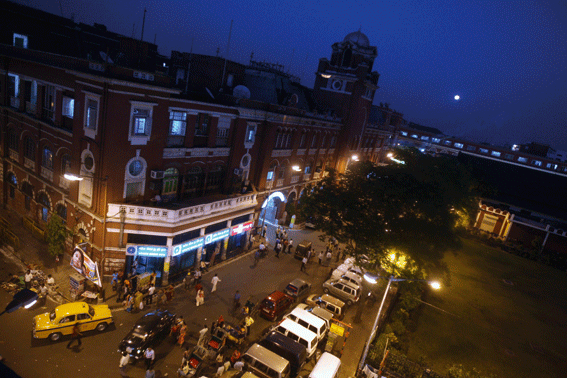
On a rainy day in the late 17th century, an enterprising agent of the British East India Company named Job Charnock sailed along the Hooghly River, a tributary of the Ganges that flows from high in the Himalayas into the Bay of Bengal, and pitched a tent on its swampy banks. The company bought three riverside villages. Soon they would become a port – flowing with muslin and jute – and then, as the capital of British India until 1912, draw conquerors, dreamers and hungry folk from all over the world.
Calcutta, India’s first modern city, was born.
By: Somini Sengupta
Over the years, it acquired many names: City of Palaces, Black Hole, Graveyard of the British Empire. In 2001, it was namedKolkata – slower, rounder, ostensibly more Bengali-sounding.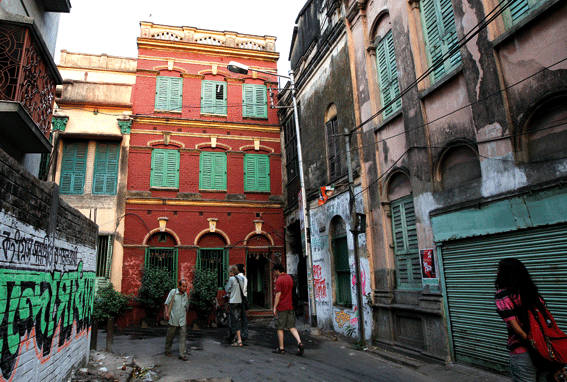
To me, it has always been the city of green shutters. They are a singular fixture of old Calcutta houses. They glow in the steamy heat of the afternoon. Trees sometimes sprout from moldy ledges.
I left Calcutta when I was small and promptly forgot what I knew, such is the thick velvet curtain the immigrant child draws over memory. Every few summers, when my family returned for holidays, I would be escorted from one relative’s house to another, scolded for being too thin and force-fed heaps of sweets. On Park Street, I would be invariably accosted by a hungry, barefoot child. The only thing more confounding than going to Calcutta was coming home to suburban Southern California; how do you explain the city of dreadful night (Rudyard Kipling’s phrase, not mine) to friends who had spent the summer listening to Olivia Newton-John?
In the last four years, over several reporting trips there, the city has revealed itself to me slowly, opening one sleepy eye at a time. Calcutta today is as parochial as it is modern. It lives in the past as much as it lets its past decay. India’s first global city, it is littered with the remains of many worlds: the rickshaws that the Chinese brought; an Armenian cemetery; dollops of jazz left by Americans in the war years.
It is as much a walker’s city as a talker’s: It has great eavesdropping potential, even if you understand only English, and it is perfectly acceptable to start up a conversation with strangers, whether about the rain or Shakespeare.
Best of all, in Calcutta, you can eat the world. The royal chefs who decamped here from the Mughal court of north India brought a cardamom-laced mutton rezala stew. The British Raj offered a canape of cheese and pineapple. From Baghdad, David Nahoum’s forefathers brought the cheese-filled sambusa to Calcutta’s New Market.
For the traveler with limited time, the best way to explore Calcutta is roughly to trace the route of the Hooghly, meandering on and off the main thoroughfares by foot, tram and subway, known here as the Metro. This is not a luxury destination. It is more a journey through the grimy layers of time. History is inscribed on every lane, like tattoos on an aging diva. Calcutta was once quite a diva.
You could start by boarding a tram at the Esplanade, just north of the Oberoi Grand Hotel, and head north on College Street, now renamed Bidhan Sarani. The last time I tried, the tram crawled through traffic and then stopped crawling entirely. The power had gone out. If you get out near College Street, as I did, make your way through the dense alleys of books (mostly used textbooks, but a careful hunt on Calcutta’s streets can turn up jewels) to the Indian Coffee House. Built in the late 1800s as the Albert Hall to commemorate a visit of the prince consort, it eventually became the city’s most venerable institution of revolutionary chatter and flirt. There is still plenty of flirt.
The waiters don’t chatter. They scowl under their white caps, thick black dirt in the stiff creases. They complain that no one orders anything. A cashier told me last summer that the cafe had been posting losses for more than 25 years. I guiltily ordered the fritter-like vegetable pakoras. Calcutta from the start has confronted some of the most acute debates of modernity. Over three centuries, the folly and ingenuity of global capitalism have left their mark on my city, and then, too, so have the Communists, who have been elected to power for an uninterrupted 31 years. Now New India pokes its finger into Calcutta’s languid belly. The old houses are making way for tall glass and steel, their Calcutta Deco details tossed away like fish-heads. Flury’s, once a classic European patisserie, serves American-style lasagna instead of the white bread cucumber sandwiches of my childhood. The hammer and sickle remains the refrain of Calcutta graffiti, interrupted now by posters for English classes, the hammer and sickle, you might say, of Indian aspiration today.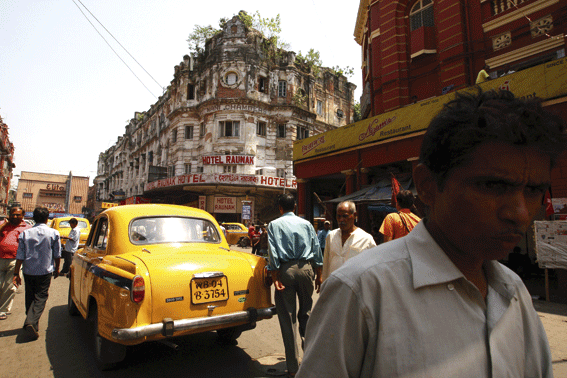
“Great cities get old and somehow renew themselves,” said Mani Sankar Mukherji, whose remarkable 1962 novel, “Chowringhee,” chronicled life inside a roaring midcentury Calcutta hotel. Calcutta, he confessed, cannot be called a great city.
Pradip Kakkar, who, with his wife, Bonani, leads a citizens’ lobby called Public, short for People United for Better Living in Calcutta, was somewhat more generous. “Calcutta is newing itself,” he said.
Public has campaigned to remove billboards that obscure heritage buildings and save the wetlands that naturally drain and clean Calcutta’s waste. Calcutta has no sewage treatment plant. The wetlands, Mrs. Kakkar said, are like the city’s kidney. They are also a sanctuary of cormorants and wagtails, where fishermen and farmers grow food on a patchwork of ponds and fields.
Around the corner from the Coffee House on College Street stands Presidency College, founded by Indian philanthropists in 1817 as a center for the teaching of European thought.
A short tram ride north along College Street takes you to Bethune College, created in 1849 as the city’s first school for girls, a remarkable feat, considering that most privileged Indians secluded their women in purdah at the time. My own grandmother, a lawyer’s daughter, could study only until the age of 13.
On the south side of the college is the family-owned Girish Chandra Dey and Nakur Chandra Nandy, makers of nothing else but the celebrated Bengali shondesh. To its detractors, including me, the shondesh, made of sweetened slow-stirred cheese, resembles cement. To its fans, it is proof of divine love, eaten at any time of day, and always when there is something to celebrate.
Pranab Nandy, 46, a fifth-generation confectioner, sat cross-legged in a dhoti and ribbed white undershirt on an unseasonably warm day in January. He seemed not the least worried about New Indian tastes cutting into his business. “Demand remains. It will always remain,” he said. “Whenever there is happiness, there must be shondesh.”
In winter the shondesh is sweetened with palm syrup, and it had arrived from the countryside this afternoon in terra-cotta pitchers. Mr. Nandy, without stirring from his perch, ordered his latest creations to be fetched – one stuffed with coconut and nuts, another with a truffle-like injection of palm syrup, a third dunked in syrup. The Nandy workshop’s green walls were plastered with posters. Men sat on the floor, crafting each shondesh from wooden molds. Not that the Nandys have eschewed New India. They now have an outlet inside an air-conditioned supermarket.
From Mr. Nandy’s shop, the walker (unless burdened with sacks of shondesh, as I was) could head north and then west into the heart of the erstwhile Black Town, where Indians rich and poor were concentrated in the starkly segregated days of the empire. There is no evident city planning. The roads are so narrow it is difficult for cars to navigate; they flooded then and still do.
Chitpur Road was the nerve center of Black Town. The mansions on and off this boulevard, now called Rabindra Sarani, are a whimsical mixture of West and East – introverted toward courtyards according to Indian architectural tradition and boasting fabulous Western facades with Corinthian pillars and nymphs on the pediments.
Black Town was built by those whom Krishna Dutta, in her book “Calcutta: A Literary and Cultural History,” calls the Bengali compradors, who “patronized Indian classical music and the European arts, held lavish feasts and paid court to the British.” They are lyrically skewered in Amitav Ghosh’s novel “Sea of Poppies.”
The mansions are in varying stages of ruin. The height of kitsch is the Marble Palace, open to the public with a pass from the government tourism office and stuffed with crystal chandeliers and stone lions. Geoffrey Moorhouse, in his book, “Calcutta: The City Revealed,” says it looks “as if they had been scavenged from job lots on the Portobello Road on a series of damp Saturday afternoons.”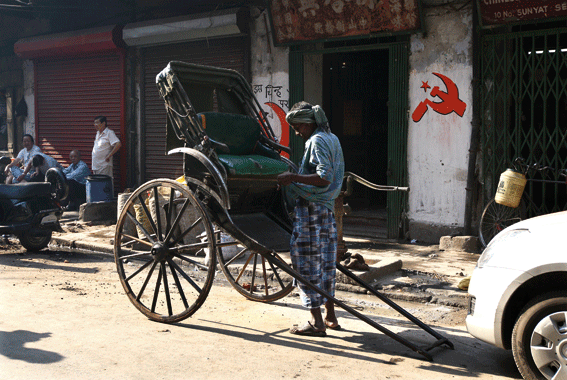
The family home of Rabindranath Tagore is on Dwarkanath Tagore Lane. The unsung mansions sit on the smaller lanes, occupied by fragments of families. Old saris hang out to dry on the balconies and dogs snooze at the feet of faux-Venus statues.
A variety of artisans hang on along Chitpur Road: makers of traditional perfumes, embroidered tunic sellers, purveyors of wigs, a row of musical instrument shops (at N. N. Mondal’s, Yehudi Menuhin got his violin repaired in 1952) and Chinese shoemakers.
A good place to stop and ponder the past is the ground-floor of the Broadway Hotel, on Ganesh Chandra Avenue. The afternoon light pours in golden soft through the shutters. Across the street, above a gas station, is a hidden gem, called Eau Chew, where Joseph and Josephine Huang serve a fabulous fish in black bean sauce.
Every guidebook will opine on the sights of Dalhousie Square, which the World Monuments Fund lists on its 100 most endangered heritage sites. I recommend a visit to the General Post Office and the adjacent Postal Museum, for their collection of old stamps and the brass buckles of the “dak” runners, or postmen, who carried letters on foot.
Calcutta’s first foreigners often died young, sometimes before they received mail from across the ocean. The Returned Letter Office housed the letters to the dead. It stands on the southeast corner of the square. The museum inside the Victoria Memorial is an archive of imperial ambition. Across the river is another kind of archive: the Indian Botanic Garden, said to house trees from five continents but its collection is poorly marked, the benches are broken and it seems better suited for canoodlers than botanists.
Much of White Town is in sad shape. A mysterious fire claimed a significant portion of the headquarters of MacKinnon Mackenzie, a prominent managing agent for British industry in Calcutta. Bow Barracks, a red-brick row of onetime army barracks and home now to Chinese and biracials known here as Anglo-Indians, is due to be demolished. Groups like Public are goading the city to start saving its past.
South Calcutta has two attractions, and they are worth exploring by Metro.
The Tollygunge Club is farther south. Built as a private Raj-era mansion, it housed the family of Tipu Sultan, another deposed Indian king from southern Mysore, and then became a whites-only club in 1895, with a racecourse as its main attraction. Today, it is primarily a golf club. Jackals have built their dens here. They seem to like to watch golf.
What the newing of Calcutta, as Mr. Kakkar puts it, will do to the soul of Calcutta is a matter of argument.
Aveek Sen, a photography critic at The Telegraph, a Calcutta-based daily, was glum. ``All the things that Calcutta is known for are on an irreversible – ``he stopped to find the word, and then made a downward motion of the hand.
Bengali theater is long past its glory days, he said. So too the Academy of Fine Arts, once a proud icon of Calcutta modernism, though several private galleries have opened in the last couple of years. The city’s biggest cultural event is an annual book fair, but new foreign books and journals, easily available in Delhi, are hard to come by here. Mr. Sen often spirits away to Delhi. He said the cultural life of Calcutta was “stifling.”
“In Calcutta, people get used to deprivation and turn it into a virtue,” he concluded. Then he paused, offering a peephole into the soul of Calcutta. “I’m saying all these dreadful things about my city. But I love living here.”
IF YOU GO
In an India awash in hurried ambition, Calcutta, with around 13 million residents, remains somewhat nonconformist, with glamour largely eschewed. Expect to see middle-aged men wearing the traditional dhoti-punjabi, a wrapped pantaloon-tunic combo, rather than Western clothes; typists-for-hire doing brisk business at sidewalk desks; and hand-pulled rickshaws. Good guidebooks are hard to find, but two that offer useful information and that are readily available are “Lonely Planet India” and “Let’s Go India.”
For a walk in the city, arm yourself with a good map, available at good hotels or bookshops, like Oxford Book Store on Park Street. The streets are not well-marked; ask for directions. Calcutta folk will rise from their seats and practically take you where you need to go. English is widely spoken.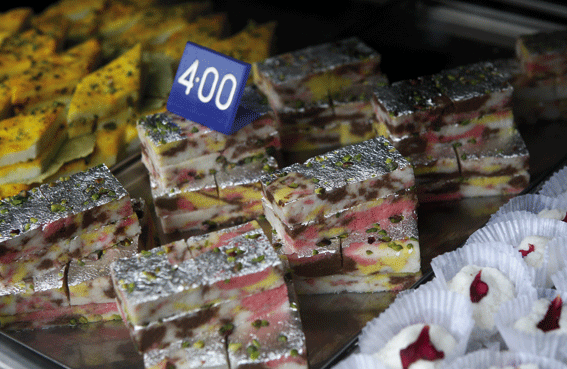
Calcutta Walks offers guided walking tours of Black Town, White Town and what it calls Grey Town, where Marwari traders, Baghdadi Jews, Zoroastrians from ancient Persia and others settled. Best of all, their tours stop for snacks. The walks take two and a half to three hours and cost 1,000 rupees, or about $20, at 50 rupees to the dollar.
WHERE TO STOP
Kumartoli potters’ colony, the traditional potters quarter, in the lanes sandwiched between Chitpur Road and the Hooghly and Sovabazar and Banamali Sarkar Streets.
Nakhoda Mosque, Chitpur Road and Zakaria Street; Muslim restaurants are nearby, some billing themselves as “pure veg” and others overflowing with mutton.
The General Post Office and adjacent Postal Museum, Dalhousie Square.
The towering Victoria Memorial Hall sits in the Maidan, the sprawling park just south of Dalhousie Square. Inside is a museum of India’s imperial history. The museum is open 10 a.m. to 5 p.m. Tuesday through Sunday; the entry fee for non-Indians is 150 rupees.
The Indian Botanical Garden is across the river in the Howrah district.
WHERE TO EAT
At Eau Chew, the fish in black bean sauce costs 450 to 550 rupees.
Kewpie’s serves traditional home-cooked Bengali food. Kewpie was Minakshie Dasgupta, one of the city’s most important food writers; her daughter, Rakhi Purnima, runs the restaurant now out of the family home, and her steamed banana blossoms, or mocha, in Bengali, is a must try. Served on terra-cotta platters, vegetarian meals cost 350 rupees; for fish and meat, the meal is 450 rupees
Prince Restaurant is an unpretentious and excellent restaurant on Free School Street, now Mirza Ghalib Street. Bhupendra Saha goes to market shortly after dawn each morning and trolls for fish, which is cooked according to his wife’s East Bengali recipes. On my last visit, prawn in coconut milk sauce was 90 rupees.